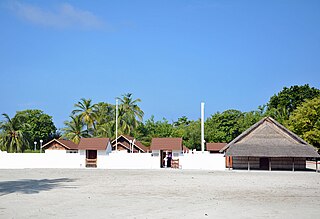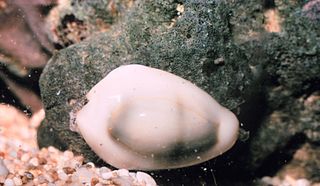
Rupee is the common name for the currencies of India, Mauritius, Nepal, Pakistan, Seychelles, and Sri Lanka, and of former currencies of Afghanistan, Bahrain, Kuwait, Oman, the United Arab Emirates, British East Africa, Burma, German East Africa, and Tibet. In Indonesia and the Maldives, the unit of currency is known as rupiah and rufiyaa respectively, cognates of the word rupee.

Mirza Mu'izz-ud-Din Beg Muhammad Khan, more commonly known as Jahandar Shah, was the ninth Mughal Emperor who ruled for a brief period in 1712–1713. He was the son of Bahadur Shah, and the grandson of Alamgir. Jahandar Shah ruled for only eleven months before being deposed. In his reign, the Deccan Subah was made almost independent by Zulfiqar Khan Nusrat Jang. Jahandar Shah was succeeded by his nephew Farrukhsiyar in 1713 CE.

The Maldivian rufiyaa is the currency of the Maldives. The issuance of the currency is controlled by the Maldives Monetary Authority (MMA). The most commonly used symbols for the rufiyaa are MVR and Rf. The ISO 4217 code for Maldivian rufiyaa is MVR. The rufiyaa is subdivided into 100 laari.
The Currency of Maldives is Rufiyaa,. The rufiyaa is divided into 100 laari.

The Coinage of India began anywhere between early 1st millennium BCE to the 6th century BCE, and consisted mainly of copper and silver coins in its initial stage. The coins of this period were Karshapanas or Pana. A variety of earliest Indian coins, however, unlike those circulated in West Asia, were stamped bars of metal, suggesting that the innovation of stamped currency was added to a pre-existing form of token currency which had already been present in the Janapadas and Mahajanapada kingdoms of the Early historic India. The kingdoms that minted their own coins included Gandhara, Kuntala, Kuru, Panchala, Magadha, Shakya, Surasena and Surashtra etc.

Utheemu is one of the inhabited islands of Haa Alif Atoll administrative division and geographically part of Thiladhummathi Atoll in the north of the Maldives. It is an island-level administrative constituency governed by the Utheemu Island Council.

The coins of the Maldivian rufiyaa are documented since it became a British protectorate in 1304 AH (1887).
Muhammed Ghiya'as ud-din, the son of Sultan Ibrahim Iskandar II, was the sultan of the Maldives from 1766 to 1773. As per the will of his predecessor Dhon Bandaarain, Muhammed Manifufaanu ascended the throne and reigned as Sultan Al-Haj Muhammed Ghiya'as ud-din Iskandar Sri Kula Sundara Maha Radun. He was the last sultan of the Dhiyamigili Dynasty; he was deposed while away on a pilgrimage, and later, on his return trip he drowned, or was murdered by Kalhu Bandaarain.
Sultan Muhammad may refer to:
Imad H. Latheef, is a Maldivian journalist, columnist and a commentator. He was the foreign news editor, in Haveeru newspaper in Maldives.

The Malé Friday Mosque or the Malé Hukuru Miskiy also known as the Old Friday Mosque is one of the oldest and most ornate mosques in the city of Malé, Kaafu Atoll, Maldives. Coral boulders of the genus Porites, found throughout the archipelago, are the basic materials used for construction of this and other mosques in the country because of its suitability. Although the coral is soft and easily cut to size when wet, it makes sturdy building blocks when dry. The mosque was added to the tentative UNESCO World Heritage cultural list in 2008 as unique examples of sea-culture architecture.

The Sultanate of Bengal, was an empire based in Bengal for much of the 14th, 15th and 16th centuries. It was the dominant power of the Ganges–Brahmaputra Delta, with a network of mint towns spread across the region. The Bengal Sultanate had a circle of vassal states, including Odisha in the southwest, Arakan in the southeast, and Tripura in the east. Its raids and conquests reached Nepal in the north, Assam in the east, and Jaunpur and Varanasi in the west. The Bengal Sultanate controlled large parts of the northern, eastern and northeastern subcontinent during its five dynastic periods, reaching its peak under Hussain Shahi dynasty. It was reputed as a thriving trading nation and one of Asia's strongest states. Its decline began with an interregnum by the Suri Empire, followed by Mughal conquest and disintegration into petty kingdoms.

British trading posts in India were first established by the East India Company (EIC) early in the seventeenth century, which quickly evolved into larger colonies covering a significant part of the subcontinent. Early settlements or factories included Masulipatnam (1611) and Madras (1640) in the south, Surat (1612) in the west, and modern-day Kolkata (1698–99) in the east. These colonies gave rise to Madras Presidency, Bombay Presidency, and Bengal Presidency, and each Presidency had a separate coinage and monetary system. In time, the EIC adopted a unified system of coinage throughout all British possessions in India and the older Presidency system was discontinued. After the Indian Rebellion of 1857, control of EIC territories passed to the British Crown. Coinage issued after 1857 were under the authority of the monarch as India became part of the British Empire. With the Royal Titles Act 1876, Victoria took the title "Empress of India", so in 1877 coin inscriptions changed from Victoria Queen to Victoria Empress. There was a transition period after India gained independence on 15 August 1947, and the first set of republic India coins were issued in 1950.
Amina I of the Maldives also called Amina Kabafaanu and Aminath Kabafan, was sultana regnant of the Maldives from 1753 until 1754. She also served as joint regent with her spouse Ali Shah Bandar Vela’ana’a Manikufa’anu in 1773 during the pilgrimage of her brother Sultan Muhammed Ghiya'as ud-din to Mecca.
Mariyam Kaba'afa'anu Rani Kilege was a Sultana consort of the Maldives by marriage to sultan Ibrahim Iskandar I of the Maldives. She served as regent of the Maldives during the minority of her son, sultan Kuda Muhammad of the Maldives, from 1687 until 1691.

The Indian 10-rupee coin is a denomination of the Indian rupee. The ₹10 coin is the second highest-denomination coin minted in India since its introduction in 2005. The present ₹10 coin in circulation is from the 2019 design. However, the previous ₹10 coins minted before 2019 are also legal tender in India. All ₹10 coins containing with and without the rupee currency sign are legal tender, as stated by the Reserve Bank of India. Along with the standard designs, there are 4 different designs for this denomination and this is used alongside the 10 rupee banknote.

The Indian 1-rupee coin (₹1) is an Indian coin worth one Indian rupee and is made up of a hundred paisas. Currently, one rupee coin is the smallest Indian coin in circulation. Since 1992, one Indian rupee coins are minted from stainless steel. Round in shape, the one rupee coins weighs 3.76 grams, has a diameter of 21.93-millimetre (0.863 in) and thickness of 1.45-millimetre (0.057 in). In independent India, one rupee coins was first minted in 1950 and is currently in circulation.











